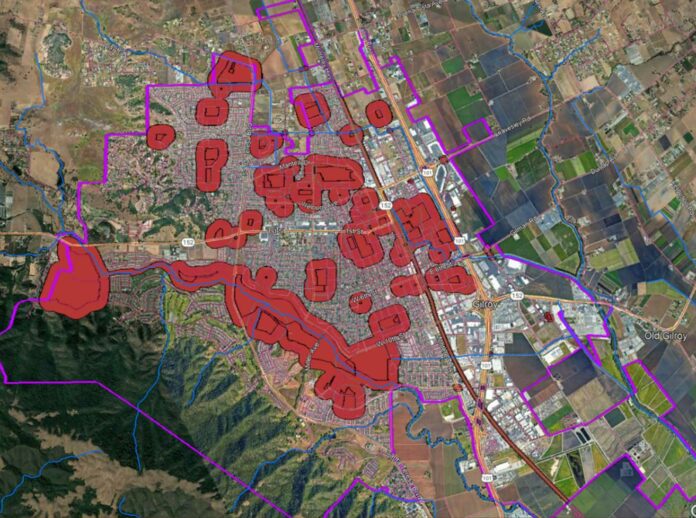The Gilroy City Council approved an ordinance on June 5 that would prohibit camping near schools, in Uvas Creek and other public right-of-ways.
However, some members of the public who spoke during the meeting said such a decision could put the city on shaky legal ground.
The ordinance passed 6-1, with Councilmember Rebeca Armendariz dissenting.
Cities throughout the country have been grappling with a 2019 decision by the Ninth District Court of Appeals in Martin v. City of Boise, which determined that outdoor public camping cannot be criminalized unless the individuals are given an alternative shelter option.
An ordinance banning camping near schools was originally discussed in July 2022 after many parents complained to the city about a large encampment underneath a bridge on IOOF Avenue near South Valley Middle and other schools.
Other people have addressed the city council in recent months, stating they have been harassed or threatened by some homeless individuals who reside in the encampments.
The council later directed city staff to craft an ordinance that furthers the ban to include parks, daycares and what is referred to as “critical infrastructure.”
Assistant to the City Administrator Bryce Atkins said the ordinance only affects city-owned property that is within the public right-of-way. As such, it would apply to roughly 24% of the city, including water wells, bridges and over/underpasses.
Uvas Creek also falls under the proposal, and Atkins said it would affect between 75 to 100 people who are living there.
Atkins said the ordinance will become effective July 19 once adopted on the June 19 consent agenda, and city staff will begin outreach to service providers and those impacted by the policy.
More than 20 people spoke to the council during the June 5 meeting, in addition to numerous letters emailed to the members since the ordinance was reviewed on May 15.
Gilroy Unified School District Superintendent Deborah Flores said schools such as Ascencion Solorsano Middle School and Gilroy Prep School have noticed an uptick in the number of homeless people who live nearby, with many “behaving erratically and frightening children.”
“I know that the homeless issue is a complicated one that requires solutions that balance the needs of our homeless population with the needs of our community,” she said. “However, I’m here to represent the needs of our children and youth that should be a top priority in my mind. It’s our obligation as a community to do everything we can to keep our children safe.”
Vanessa Ashford of Carry the Vision said many children are also homeless, with some 200 students estimated to be unhoused in a school district of more than 10,000 students.
But she questioned how the unhoused could be directed to resources in the city, when such service providers are already at capacity.
“No one has contacted the service providers from the council or city staff asking if we can, and the answer is we cannot,” Ashford said. “There are no resources. There is no shelter, so I’m not sure how that enforcement is going to work.”
Tristia Bauman of the Law Foundation of Silicon Valley said the city could be exposing itself to litigation, adding that the policy “targets the same conduct that was at issue with Boise.”
“It would be enforced against people that do not have access to housing or shelter alternatives,” Bauman said. “The proposal seems to hinge on a single line in the footnote in the Martin decision that there may be spaces outside banned areas that people can be. But people do not know where they can be.”
In a report to the council, city staff emphasized a line in the Boise decision that read: “Even where shelter is unavailable, an ordinance prohibiting sitting, lying, or sleeping outside at particular times or in particular locations might well be constitutionally permissible.”
City Attorney Andy Faber said the city could defend itself successfully in court if a lawsuit was filed.
“We believe the law as written is enforceable and is not unconstitutional,” he said.
Armendariz, who cast the lone dissenting vote on the ordinance, called it “overreaching and discriminatory.”
“If we are writing a policy that is barely legal, that is barely constitutional, and we’re directing city staff to do that, we need to stop and take a look at ourselves and say why are we doing this,” she said. “What kind of bullies are we being if we’re focusing on people who are already downtrodden, already the most marginalized and already living in a way they don’t want to live.”
Hilton said that while he was still uncomfortable with parts of the ordinance, he believed it is trying to strike a balance. He said he appreciated Police Chief Pedro Espinoza’s response that the officers would use a common sense approach when enforcing the ordinance and treat every instance on a case-by-case basis, adding that he would “hold him to that.”
Councilmember Carol Marques said Las Animas Veterans Park has become “sketchy” in the last few weeks, citing instances of a man “high on drugs” harassing people using the tennis courts that resulted in a police response, as well as a woman chasing people out of the dog park saying “one word at the top of her lungs, and it begins with ‘f.’”
“I have nothing against an unhoused person sitting on a bench, taking a nap on the grass,” she said. “But I do have a problem with someone who’s making our lives dangerous to be out there because of their mental instability. No one should have to be afraid to walk their child to school, but that’s what it’s become for many of our school campuses.”
Mayor Marie Blankley said the city has taken a number of steps in recent years to tackle the homelessness crisis, such as working with the county to establish an affordable housing project at the corner of Eighth and Alexander streets, and providing funding to unhoused service providers through the Community Development Block Grant process.
“This agenda item is about protecting our children and critical infrastructure from the known issues, activities and behaviors that threaten public safety,” she said. “Our sworn duty is to the safety of the public at large, and for that we have a duty to act when public safety is threatened. That’s what we’re trying to do.”
















Find the money to hire back the city worker the city layoff
Typical NIMBY attitude; move the problem to a neighborhood without schools nearby. Pathetic.